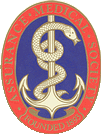AMUS (Assurance Medical and Underwriting Society) was formed from the merger of The Assurance Medical Society (AMS) and the Association of Medical Underwriters (AMU).
Origins
The Society was originally formed in 1893 by a group of doctors working for Life Offices as the Life Assurance Medical Officers Association (LAMOA), changing its name to The Assurance Medical Society in 1915.
The aims of the Society have changed little over the years. In the early days the object was ‘the discussion of the medical aspects of subjects connected to life and other forms of insurance with a view to obtaining increased information and greater unity of opinion’. Today the principal aim is ‘the education of medical practitioners, actuaries, insurance underwriters and those associated professions on matters relating to those diseases and medical complaints that affect life or other forms of insurance’.
Learned Papers
The first paper was read to the society on March 28th 1894 by Dr George Vivian Poore, a member of council, on the subject of the significance of slight degrees of albuminuria and its relation to Life Assurance. A lively discussion is reported to have followed (two days later apparently). Dr Poore expressed the need to have the urine passed in the presence of the examiner and the need to follow up cases rejected on account of albuminuria: others advocated the use of microscopy ant the value of having morning and evening specimens – so called functional albuminuria was well described.
This was the pattern set for meetings of the Society over the years – normally three times each year at the house of the Medical Society of London where papers were read and discussed and subsequently being included in the Transactions of The Society provided to all members.

Membership
Until the 1950’s membership had been amongst doctors associated in some way with Insurance Offices. As a result of the increasingly close relationship with both actuaries and others involved with underwriting and claims administration more non-medically qualified people became members. Today the Chief or senior underwriter of subscribing offices is welcome as full members. The Council, whilst being predominately medical contains non-medically qualified persons and there have been two presidents of the Society who were not doctors.
Meetings and Symposia
The society has moved away from being regarded as solely a learned society in the past decade or so. Joint full day meetings have taken place with the Institute of Actuaries and The Royal College of Physicians with further meetings planned. Meetings have been organised on a full day basis in several of the principal towns and cities in the United Kingdom in order to forge closer links with provincial members, as well as memorable visits made to Dublin and Paris.
Education: Diplomas
Working with the Chartered Insurance Institute (the principle examining body for the insurance industry) the Society has created a Diploma in Life Underwriting. Students must pass, in addition to other specific examinations, a paper on Life and Disability Underwriting. The syllabus is produced and maintained, the questions set, and the papers marked by The Society. Students who pass the examinations may apply for the Diploma, which is granted provided there is relevant work experience. Work is currently well advanced to create a further Diploma for those involved in the management of disability and other related claims.
Other Activities
Amongst other activities the Society has Membership of the continuing Care Conference (CCC) which keeps it in touch with the challenges associated with the long term care of the elderly.
The Society is involved with the national Diploma in Disability Assessment Medicine (DIDAM) for which the examining bodies are the Faculty of Occupational Medicine and The Royal College of Physicians.
The AMU has been in existence for just over 50 years, but started life under the name of the Life Underwriters’ Club (LUC). It was the first group of underwriters to met with purpose of increasing the members’ knowledge and exchanging views on the market. It was probably the first time that underwriters, as opposed to actuaries, had met together to discuss issues that affected their day-to-day work. Originally it was only the Chief Underwriters who were members although they were allowed to bring guests such as Chief Medical Officers and other senior underwriters.
The meeting were held in London, as at that time, the vast majority of the life offices were still based here. The meeting were held on Wednesday evenings at various local restaurants with a guest speaker followed by a meal. These venues all have the joint distinction of being underground and of being in buildings that have now been demolished and rebuilt e.g. the London Underwriting Centre in Mincing Lane. For a while in the late 70s and early 80s, there was a strong link with the Assurance Medical Society (AMS) and both meetings were held on the same evening with numerous members attending the AMS in Chandos St in the West End before dashing over to the City for the LUC meeting!
In 1993, the LUC decided that the title did not really represent the activities of the club especially with the arrival of critical illness cover and the longer existence of income protection. So it was agreed to change the name to the AMU.
There was one other underwriting club in London until 2002. This was the Benefactors’ Club that had started in 1967 and met on Friday evenings. This was aimed at underwriters who were not the Chief Underwriter in their organisation. In view of the reduced number of life offices now in London, it was agreed the two clubs would merge under the name of the AMU.